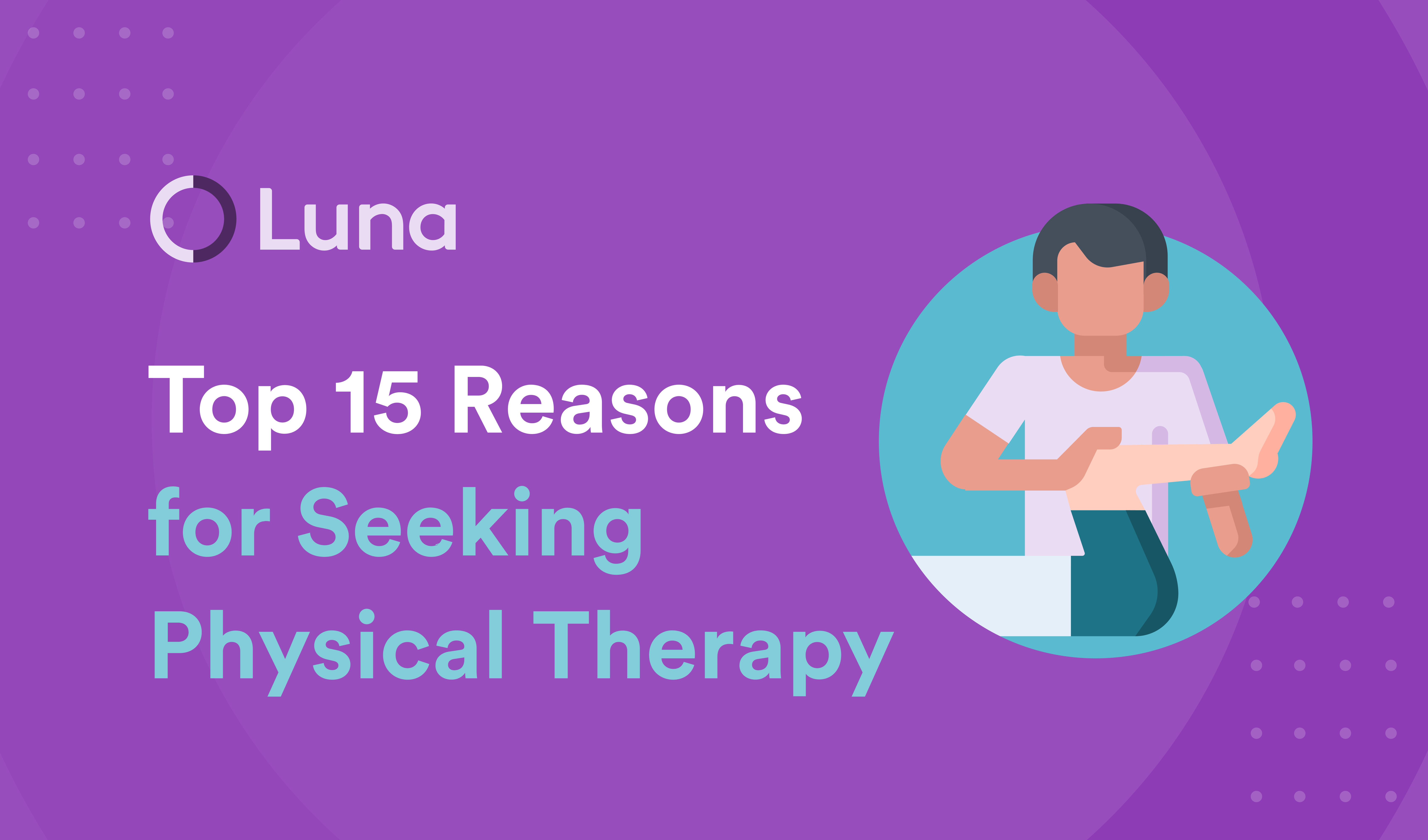15 Most Common Reasons for Physical Therapy + Who Can Benefit

In healthcare, physical therapy offers hope to those with various musculoskeletal issues. This article explores the 15 most common reasons for physical therapy (PT) and who can benefit from treatments. Whether recovering from an injury, managing a chronic condition, or aiming to improve your overall well-being, physical therapy can be pivotal for achieving and maintaining optimal health. Below, we'll delve into each reason for PT, offering insights into the conditions and situations that may necessitate physical therapy intervention.
Jump directly to the reason that interests you most:
- Injury Rehabilitation
- Pre and Post-Surgical Recovery
- Chronic Pain Management
- Orthopedic Conditions
- Sports-Related Injuries
- Neurological Disorders
- Arthritis
- Balance and Gait Disorders
- Cardiovascular and Pulmonary Conditions
- Women's Health Issues
- Pediatric Conditions
- Age-Related Mobility Issues
- Work-Related and Repetitive Strain Injuries
- Preventative Care
- Invasive Surgery

Injuries, whether from sports, accidents, or overuse, are among the most common reasons individuals seek physical therapy. From sprains and strains to fractures and dislocations, these rehabilitation, help individuals regain strength, flexibility, and function in the affected area.

Who Can Benefit: Anyone recovering from acute injuries, such as ankle injuries, muscle strains, or ligament tears, can benefit from physical therapy. By following a personalized rehabilitation program, patients can expedite their recovery and minimize the risk of long-term complications.

Physical therapy before surgery can help strengthen the muscles around the surgical area, leading to a smoother recovery. Following surgery, PT rehabilitation is often necessary to restore function and mobility to the affected area. Whether it's a joint replacement, ligament repair, or spinal surgery, physical therapy can help individuals regain strength, improve their range of motion, and reduce pain following their procedure.

Who Can Benefit: Patients undergoing surgical procedures, such as knee replacements, rotator cuff repairs, or spinal fusions, can benefit immensely from post-surgical physical therapy. Patients can optimize their recovery and achieve the best possible outcomes by working closely with a physical therapist.

Chronic pain, whether due to musculoskeletal conditions, nerve damage, or systemic diseases, can be debilitating and impact every aspect of daily life. Physical therapy offers an integrative approach to pain management, incorporating various techniques to alleviate discomfort, improve function, and enhance overall well-being.

Who Can Benefit: Individuals suffering from chronic conditions such as fibromyalgia, osteoarthritis, and neuropathy, as well as back, neck, and headaches, can benefit from physical therapy interventions aimed at reducing pain and improving quality of life. By addressing underlying imbalances and weaknesses, physical therapists help patients develop strategies to manage their pain more effectively.

Orthopedic conditions affecting the bones, joints, muscles, and connective tissues are prevalent among individuals of all ages. Whether it's osteoarthritis, tendonitis, or scoliosis, physical therapy can provide targeted interventions to address pain, improve mobility, and prevent further progression of these conditions.

Who Can Benefit: Patients diagnosed with orthopedic conditions, such as rotator cuff injuries, carpal tunnel syndrome, or herniated discs, can benefit from physical therapy to improve strength, flexibility, and function in the affected area. By incorporating exercises, manual therapy, and modalities, physical therapists tailor treatment plans to meet each patient's unique needs.

Athletes and fitness enthusiasts are prone to various injuries, ranging from sprains and strains to stress fractures and tendonitis. Whether you're a weekend warrior or a professional athlete, physical therapy can help you recover from sports-related injuries, regain strength, and safely return to activities.

Who Can Benefit: Athletes recovering from sports-related injuries, such as ACL tears, tennis elbow, or runner's knee, can benefit from physical therapy interventions designed to restore function, prevent re-injury, and enhance performance. By focusing on sport-specific rehabilitation techniques, physical therapists help athletes achieve their goals and get back on the game.

Neurological disorders, including stroke, Parkinson's disease, and multiple sclerosis, can have profound effects on mobility, coordination, and overall function. Physical therapy is vital in helping individuals with neurological conditions regain independence, improve movement patterns, and enhance their quality of life.

Who Can Benefit: Patients living with neurological disorders, including stroke survivors, can benefit from physical therapy interventions. PT would be aimed at optimizing movement, balance, and coordination. By incorporating neurorehabilitation techniques like gait training, balance exercises, and functional activities, physical therapists help patients achieve their maximum potential and regain independence in daily activities.

Arthritis, a common condition characterized by inflammation of the joints, can cause pain, stiffness, and reduced mobility. Physical therapy offers non-invasive interventions to manage symptoms, improve joint function, and enhance the overall quality of life for individuals living with arthritis.

Who Can Benefit: Individuals diagnosed with rheumatoid arthritis, or psoriatic arthritis can benefit from physical therapy. PT interventions aim to reduce pain, improve joint mobility, and preserve function. Through a combination of exercise, manual therapy, and education, physical therapists empower arthritis patients to manage their pain better, maintain an active lifestyle, and improve their quality of life.

Balance and gait disorders, common among older adults and individuals with neurological conditions, can increase the risk of falls and impact mobility. Physical therapy offers targeted interventions to improve balance, coordination, and walking patterns, reducing the risk of falls and enhancing overall safety.

Who Can Benefit: Patients with a history of falls, vertigo, or other balance and gait disorders, such as Parkinson's disease, stroke, or peripheral neuropathy, can benefit from physical therapy. PT interventions aim to improve stability, mobility, and confidence in walking. By implementing balance exercises, gait training, and assistive devices as needed, physical therapists help patients regain independence and reduce their risk of falls.

Cardiovascular and pulmonary conditions, including heart disease, chronic obstructive pulmonary disease (COPD), and asthma, can impact one's ability to perform daily activities and exercise safely. Physical therapy can help improve exercise tolerance, manage shortness of breath, and strengthen the muscles needed for breathing.

Who Can Benefit: Patients recovering from cardiac events, undergoing lung surgeries, or managing chronic respiratory conditions can benefit from cardiopulmonary rehabilitation programs offered by physical therapists. By incorporating aerobic exercise, breathing techniques, and lifestyle modifications, physical therapists help patients improve their cardiovascular health.

Women may experience a variety of musculoskeletal and pelvic health issues throughout their lives, including pregnancy-related pain, pelvic floor dysfunction, and urinary incontinence. Physical therapy offers specialized interventions to address these concerns, improve function, and enhance overall quality of life for women of all ages.

Who Can Benefit: Women experiencing pregnancy-related pain, pelvic floor dysfunction, or postpartum issues can benefit from physical therapy interventions tailored to their specific needs. Physical therapists help women regain strength, mobility, and confidence in their bodies during and after pregnancy by incorporating exercises, manual therapy, and education.

Children and adolescents may encounter various musculoskeletal and developmental conditions that impact their mobility and function. Physical therapy can help address developmental delays, improve coordination, and manage chronic conditions.

Who Can Benefit: Children and adolescents with conditions such as cerebral palsy, scoliosis, developmental delay, or sports injuries can benefit from physical therapy interventions. PT exercises, play-based activities, and family-centered care, physical therapists help young patients thrive.

As individuals age, they may experience a decline in mobility and function due to age-related muscle weakness. Physical therapy offers targeted interventions to address these age-related changes, improve mobility, and enhance overall quality of life for older adults.

Who Can Benefit: Older adults experiencing mobility issues, balance problems, or age-related musculoskeletal conditions can benefit from physical therapy interventions to improve strength, flexibility, and functional independence. By incorporating exercises, fall prevention strategies, and assistive devices as needed, physical therapists help older adults maintain their independence and age gracefully.

Repetitive strain injuries (RSIs) are common in people who perform repetitive tasks at work. Work-related injuries from lifting heavy objects or workplace accidents can impact one's ability to perform job duties and affect overall well-being. Physical therapy offers rehabilitation programs tailored to address work-related injuries, restore function, and facilitate a safe return to the workplace.

Who Can Benefit: Individuals like office and warehouse workers, musicians, and athletes who perform repetitive motions (e.g., baseball pitchers) can benefit from physical therapy. PT interventions aim to reduce pain, improve function, and prevent re-injury. Physical therapists help individuals regain confidence in their abilities and resume their occupational roles by incorporating ergonomic education, functional rehabilitation, and gradual return-to-work programs.

While physical therapy is often associated with injury rehabilitation and management of chronic conditions, it also plays a crucial role in preventive care. Physical therapists help individuals prevent injuries, manage chronic conditions, and maintain optimal physical function throughout life by identifying risk factors, addressing imbalances, and promoting healthy movement patterns.

Who Can Benefit: Individuals of all ages and activity levels can benefit from preventive physical therapy to reduce the risk of injury, improve performance, and promote long-term health and well-being. Whether you're an athlete looking to prevent sports-related injuries, an older adult aiming to maintain mobility and independence, or someone seeking to optimize their overall health, preventive physical therapy can help you stay active, functional, and injury-free.

In some cases, physical therapy can provide an effective alternative to invasive surgical procedures. By addressing underlying musculoskeletal imbalances, strengthening supportive structures, and optimizing movement patterns, physical therapy can often alleviate pain, improve function, and restore quality of life without surgery.

Who Can Benefit: Individuals diagnosed with musculoskeletal conditions, such as rotator cuff tears, meniscal tears, or spinal disc herniation, may benefit from physical therapy as a conservative approach to managing their symptoms and avoiding surgery. Through targeted exercise programs, manual therapy techniques, and education on self-management strategies, physical therapists help patients explore non-invasive options for addressing their conditions and achieving optimal outcomes.
The Convenience of In-Home Physical Therapy with Luna
While traditional outpatient physical therapy has its benefits, Luna's in-home physical therapy adds an extra level of convenience and comfort, which is particularly advantageous for individuals coping with the conditions discussed in this article. Here's how Luna's in-home approach can help you achieve your recovery goals:
- Convenience: With in-home physical therapy, you can skip the commute to and from a clinic, saving you time and hassle.
- Personalized Care: Our highly experienced, board-certified physical therapists provide one-on-one attention in the familiar surroundings of your home, tailoring treatment plans to your unique needs and goals.
- Comfort and Privacy: In-home sessions offer a comfortable and private setting where you can focus on your rehabilitation without distractions.
- Safety: For individuals with mobility limitations or transportation challenges, in-home physical therapy ensures access to essential rehabilitative care without the risk of traveling to a clinic.
- Family Environment: In-home sessions allow family members to participate in the rehabilitation process, promoting support and involvement in your journey to recovery.
If you're experiencing any of the 15 most common reasons for physical therapy mentioned above, don't let mobility issues or health concerns hold you back from treatment. Experience the convenience of Luna's in-home physical therapy services and take control of your health today. Find a therapist near you and take the first step toward better care and faster healing.




